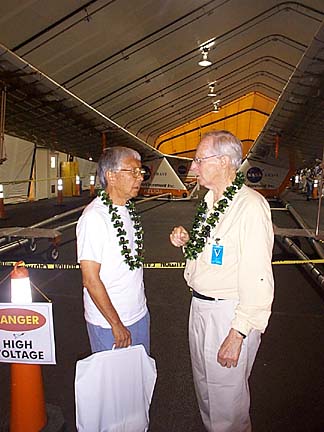


BARKING SANDS, Kauai >> "There's nothing like it in the world, that's for sure," said Paul MacCready, founder of AeroVironment, the company that built the massive Helios solar-powered flying wing for NASA. NASA’s solar wing
will pursue record
over KauaiRemote-flown Helios will try
By Anthony Sommer
to fly higher than spy jet SR-71
Kauai correspondentHelios was officially welcomed at a blessing ceremony yesterday at the Navy's Pacific Missile Range, where it is scheduled to begin test flights the first week in June.
Sometime this summer it will try for a world altitude record flight of 100,000 feet. That will top the 80,000-foot record set by the SR-71 Blackbird spy plane for jets (although MacCready said the actual maximum altitude for the SR-71 is classified and likely somewhat higher) and the 80,201 propeller-driven aircraft altitude record set by AeroVironment's Pathfinder Plus solar plane flying over Kauai in 1998.
"Each 10,000 feet gets tougher. It really is a stretch of technology," MacCready said.
MacCready, 75, whose background is in physics and aeronautics, has been a pioneer in many areas. He was among the first to conduct cloud-seeding experiments in the 1940s. Today his company makes a wide variety of products ranging from a battery-powered leaf blower to a video surveillance airplane only 6 inches long.

AeroVironment, founded in 1971, developed the first ultralight human-powered (using foot pedals) airplane, Gossamer Condor, in 1977, and two years later the Gossamer Albatross, which made the first human-powered flight across the English Channel.MacCready then "put a solar panel on it to make it the first solar-powered airplane." Called Gossamer Penguin, its maximum altitude was only 10 feet. The next step was the Solar Challenger, which could reach 11,000 feet and which made the first solar-powered flight across the English Channel in 1980. Much of the basic design of Helios came from the Solar Challenger.
MacCready said the military asked him to experiment with an unmanned solar-powered surveillance aircraft in the 1980s, "but I had to tell them the technology required was not yet available."
The concept of solar-powered airplanes was dormant for more than a decade. MacCready turned his efforts to solar- and electric-powered cars for General Motors. When NASA became interested in high-altitude atmospheric experiments in the 1990s, MacCready returned to designing solar aircraft.
AeroVironment's Pathfinder flew from Kauai in 1997, and the same aircraft with a wider wingspan and more motors, renamed Pathfinder Plus, flew from the Pacific Missile Range in 1998.
Earlier this month, NASA announced Pathfinder Plus will get new life in three years of experimental photographic flights over Kauai Coffee's plantation, beginning next year.
Helios is the latest, largest and most ambitious solar plane to date. It has made low-level test flights on battery power in California, but its two series of test flights this year and in 2003 from Kauai, when it will carry storage batteries still being designed, will determine whether solar aircraft are ready for commercial production.
"When it goes into production, the solar aircraft's role will be as a telecommunications platform capable of remaining aloft for months at a time," MacCready said.
The key to Helios is "extreme simplicity," he said. Using 14 of the most advanced electric motors in the world, it will be capable of operating at sea level and at 100,000 feet, where the air is only 1 percent as dense as it is near the ground.
Three different propellor designs will be used in order to get optimum performance at all altitudes -- and even then the top speed will be only 25 miles per hour.
The Helios will be flown by remote control from a large van parked at the missile base. Its wingspan -- 246 feet, wider than any airplane -- is so great that it will take off and land on the tarmac adjacent to the main runway, which is too narrow for Helios to use.
MacCready said his role today is to "get the projects going" and then turn them over to his engineering team. "They're amazing," he said. "I just stand back and let them do it."
MacCready admits he worries when his experimental aircraft are flying.
"We've had a perfect record so far," he said. "But we're pushing the envelope, and we know there will be things that develop that we weren't prepared for."
"The way I like to watch the flights best is on video after they're all over and I already know the outcome."